Changing Trends in Temperatures and Rainfalls in the Western Pacific: Guam
Abstract
1. Introduction
2. Study Region, Data, and Methodology
2.1. Study Area and Data
2.2. Climate Change Detection Indices
2.3. Trend Analysis
- Case 1: p-value ≤ 0.05 ⇒ significant strong trend
- Case 2: 0.05 < p-value ≤ 0.1 ⇒ significant trend
- Case 3: p-value > 0.1 ⇒ insignificant trend
3. Results and Discussion
3.1. Trends in Temperatures
3.2. Trends in Rainfalls
3.2.1. Basic Index
3.2.2. Extreme Rainfall Index
4. Conclusions
Author Contributions
Funding
Data Availability Statement
Conflicts of Interest
References
- Mycoo, M.; Wairiu, M.; Campbell, D.; Duvat, V.; Golbuu, Y.; Maharaj, S.; Nalau, J.; Nunn, P.; Pinnegar, J.; Warrick, O. Small Islands. In Climate Change 2022: Impacts, Adaptation and Vulnerability. Contribution of Working Group II to the Sixth Assessment Report of the Intergovernmental Panel on Climate Change; Cambridge University Press: Cambridge, UK; New York, NY, USA, 2022. [Google Scholar]
- Khalid, S.; Khan, H.A.; Arif, M.; Altawaha, A.R.; Adnan, M.; Fahad, S.; Shah, A.; Parmar, B. Effects of climate change on irrigation water quality. In Environment, Climate, Plant and Vegetation Growth; Springer: Cham, Switzerland, 2020; pp. 123–132. [Google Scholar]
- Pearce, T.; Currenti, R.; Mateiwai, A.; Doran, B. Adaptation to climate change and freshwater resources in Vusama village, Viti Levu, Fiji. Reg. Environ. Change 2018, 18, 501–510. [Google Scholar] [CrossRef]
- Comeros-Raynal, M.T.; Lawrence, A.; Sudek, M.; Vaeoso, M.; McGuire, K.; Regis, J.; Houk, P. Applying a ridge-to-reef framework to support watershed, water quality, and community-based fisheries management in American Samoa. Coral Reefs 2019, 38, 505–520. [Google Scholar] [CrossRef]
- Smith, J.E.; Hunter, C.L.; Smith, C.M. The effects of top–down versus bottom–up control on benthic coral reef community structure. Oecologia 2010, 163, 497–507. [Google Scholar] [CrossRef] [PubMed]
- Gingerich, S.B. The Effects of Withdrawals and Drought on Groundwater Availability in the Northern Guam Lens Aquifer, Guam: US Geological Survey Scientific Investigations Report 2013–5216; U.S. Geological Survey: Reston, VA, USA, 2013. [Google Scholar]
- Simard, C.A.; Lander, M.A.; Habana, N.C. Salinity in the Northern Guam Lens Aquifer: WERI Technical Report; Water and Environmental Research Institute, University of Guam: Mangilao, GU, USA, 2015; p. 82. [Google Scholar]
- Choi, G.; Collins, D.; Ren, G.; Trewin, B.; Baldi, M.; Fukuda, Y.; Afzaal, M.; Pianmana, T.; Gomboluudev, P.; Huong, P.T.T.; et al. Changes in means and extreme events of temperature and precipitation in the Asia-Pacific Network region, 1955–2007. Int. J. Climatol. A J. R. Meteorol. Soc. 2009, 29, 1906–1925. [Google Scholar] [CrossRef]
- Grecni, Z.; Miles, W.; King, R.; Frazier, A.; Keener, V. Pacific Islands Regional Climate Assessment. In Climate Change in Guam: Indicators and Considerations for Key Sectors; East-West Center: Honolulu, HI, USA, 2020. [Google Scholar]
- Lough, J.M.; Meehl, G.A.; Salinger, M.J. Observed and projected changes in surface climate of the tropical Pacific. In Vulnerability of Tropical Pacific Fisheries and Aquaculture to Climate Change; Secretariat of the Pacific Community: Noumea, New Caledonia, 2011; pp. 49–99. [Google Scholar]
- Marra, J.J.; Kruk, M.C.; Abecassis, M.; Diamond, H.; Genz, A.; Heron, S.F.; Lander, M.; Liu, G.; Potemra, J.T.; Sweet, W.V.; et al. State of Environmental Conditions in Hawaii and the US Affiliated Pacific Islands under a Changing Climate: 2017; NOAA NCEI; John C. Stennis Space Center: Hancock County, MS, USA, 2017. [Google Scholar]
- McGree, S.; Herold, N.; Alexander, L.; Schreider, S.; Kuleshov, Y.; Ene, E.; Finaulahi, S.; Inape, K.; MacKenzie, B.; Malala, H.; et al. Recent changes in mean and extreme temperature and precipitation in the Western Pacific Islands. J. Clim. 2019, 32, 4919–4941. [Google Scholar] [CrossRef]
- Taylor, S.; Kumar, L. Global climate change impacts on pacific islands terrestrial biodiversity: A review. Trop. Conserv. Sci. 2016, 9, 203–223. [Google Scholar] [CrossRef]
- Caesar, J.; Alexander, L.V.; Trewin, B.; Tse-Ring, K.; Sorany, L.; Vuniyayawa, V.; Keosavang, N.; Shimana, A.; Htay, M.M.; Karmacharya, J.; et al. Changes in temperature and precipitation extremes over the Indo-Pacific region from 1971 to 2005. Int. J. Climatol. 2011, 31, 791–801. [Google Scholar] [CrossRef]
- Tank, A.M.G.K.; Zwiers, F.W.; Zhang, X. Climate Data and Monitoring WCDMP-72: Guidelines on Analysis of Extremes in a Changing Climate in Support of Informed Decisions for Adaptation; World Meteorological Organization: Geneva, Switzerland, 2009; p. 56. [Google Scholar]
- Hong, Y.; Ying, S. Characteristics of extreme temperature and precipitation in China in 2017 based on ETCCDI indices. Adv. Clim. Change Res. 2018, 9, 218–226. [Google Scholar]
- Chervenkov, H.; Slavov, K. ETCCDI climate indices for assessment of the recent climate over southeast Europe. In Advances in High Performance Computing: Results of the International Conference on “High Performance Computing” Borovets, Bulgaria, 2–6 September 2019; Springer: Cham Switzerland, 2021. [Google Scholar]
- Kang, K.K.; Lee, D.S.; Hwang, S.H.; Kim, B.S. Analysis of extreme weather characteristics change in the Gangwon province using ETCCDI indices. J. Korea Water Resour. Assoc. 2014, 47, 1107–1119. [Google Scholar] [CrossRef]
- Taboroši, D.; Hirakawa, K.; Sawagaki, T. Carbonate precipitation along a microclimatic gradient in a Thailand cave—Continuum of calcareous tufa and speleothems. J. Cave Karst Stud. 2005, 67, 69–87. [Google Scholar]
- Tracey, J.I., Jr.; Schlanger, S.O.; Stark, J.T.; Doan, D.B.; May, H.G. General Geology of Guam; United States Government Printing Office: Washington, DC, USA, 1964. [Google Scholar]
- Mark, L.; Chip, G. Creation of a 50-Year Rainfall Database, Annual Rainfall Climatology, and Annual Rainfall Distribution Map for Guam. In WERI Technical Report 2003; Water and Environmental Research Institute of the Western Pacific: Mangilao, GU, USA, 2003; p. 31. [Google Scholar]
- Qian, B.; Gregorich, E.G.; Gameda, S.; Hopkins, D.W.; Wang, X.L. Observed soil temperature trends associated with climate change in Canada. J. Geophys. Res. Atmos. 2011, 116, D02106. [Google Scholar] [CrossRef]
- Pettitt, A.N. A non-parametric approach to the change-point problem. J. R. Stat. Soc. Ser. C (Appl. Stat.) 1979, 28, 126–135. [Google Scholar] [CrossRef]
- Sen, P.K. Estimates of the regression coefficient based on Kendall’s tau. J. Am. Stat. Assoc. 1968, 63, 1379–1389. [Google Scholar] [CrossRef]
- Almeida, C.T.; Oliveira-Júnior, J.F.; Delgado, R.C.; Cubo, P.; Ramos, M.C. Spatiotemporal rainfall and temperature trends throughout the Brazilian Legal Amazon, 1973–2013. Int. J. Climatol. 2017, 37, 2013–2026. [Google Scholar] [CrossRef]
- Sharma, D.; Babel, M.S. Trends in extreme rainfall and temperature indices in the western Thailand. Int. J. Climatol. 2014, 34, 2393–2407. [Google Scholar] [CrossRef]
- Wu, C.; Huang, G.; Yu, H.; Chen, Z.; Ma, J. Spatial and temporal distributions of trends in climate extremes of the Feilaixia catchment in the upstream area of the Beijiang River Basin, South China. Int. J. Climatol. 2014, 34, 3161–3178. [Google Scholar] [CrossRef]
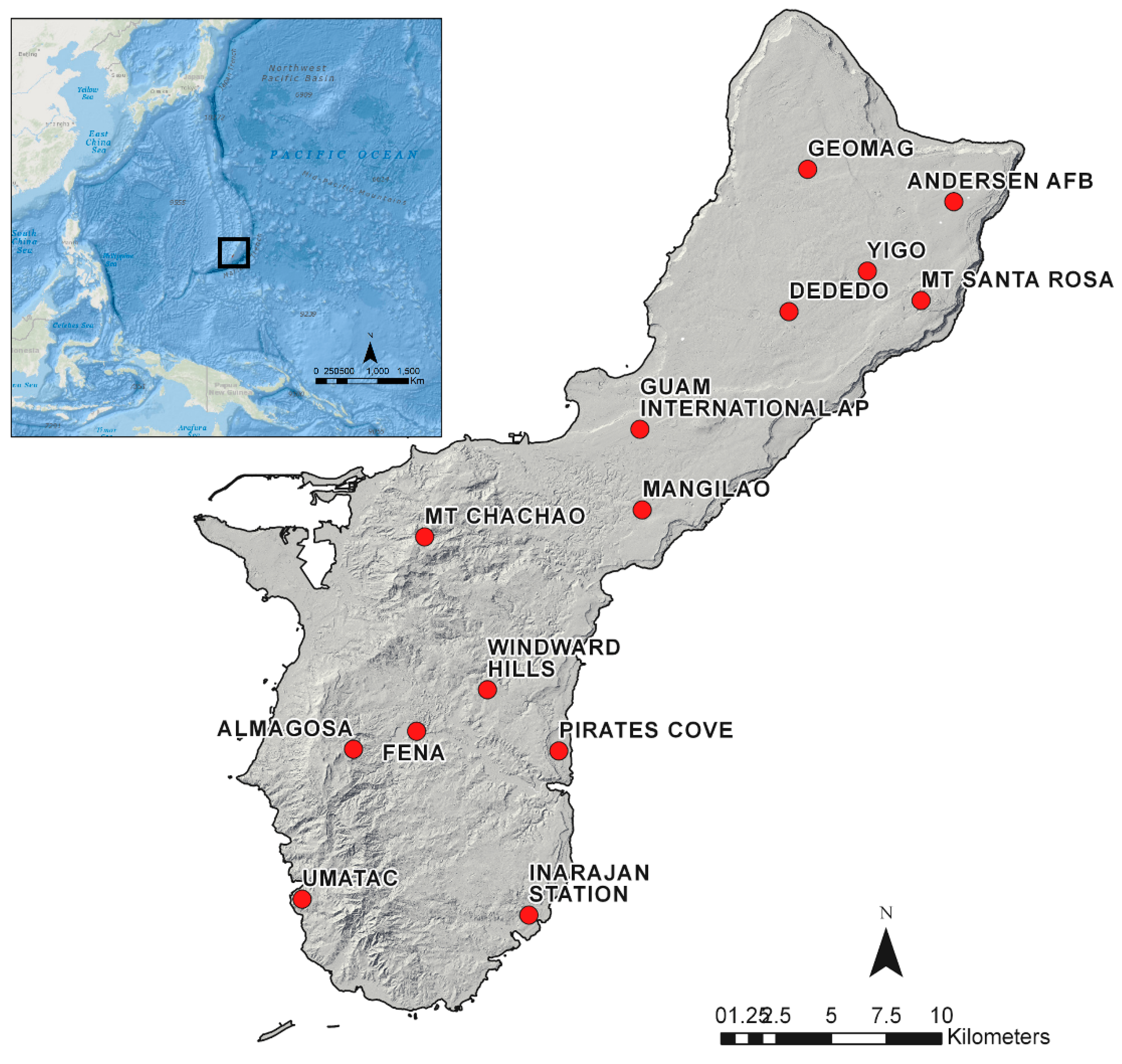
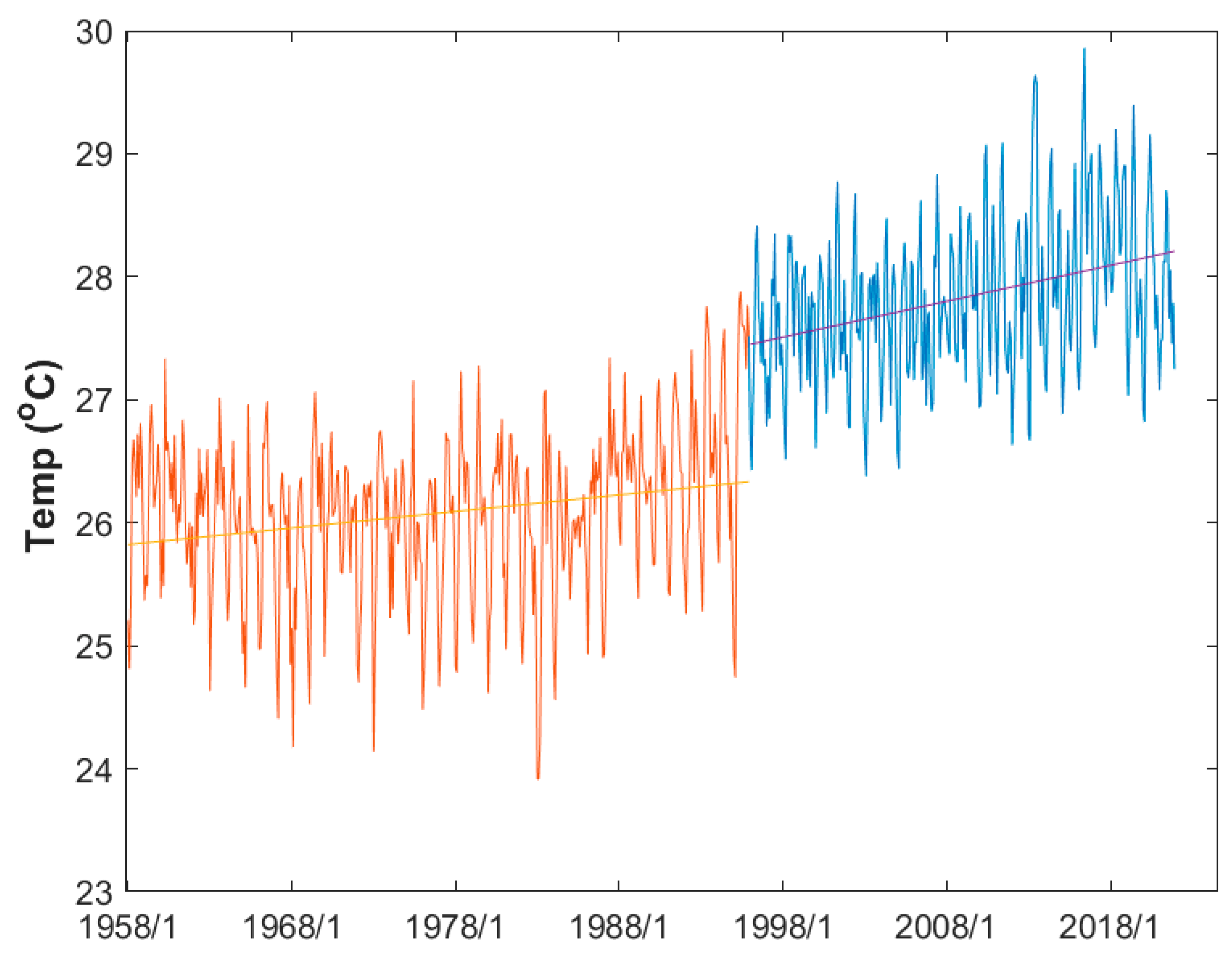
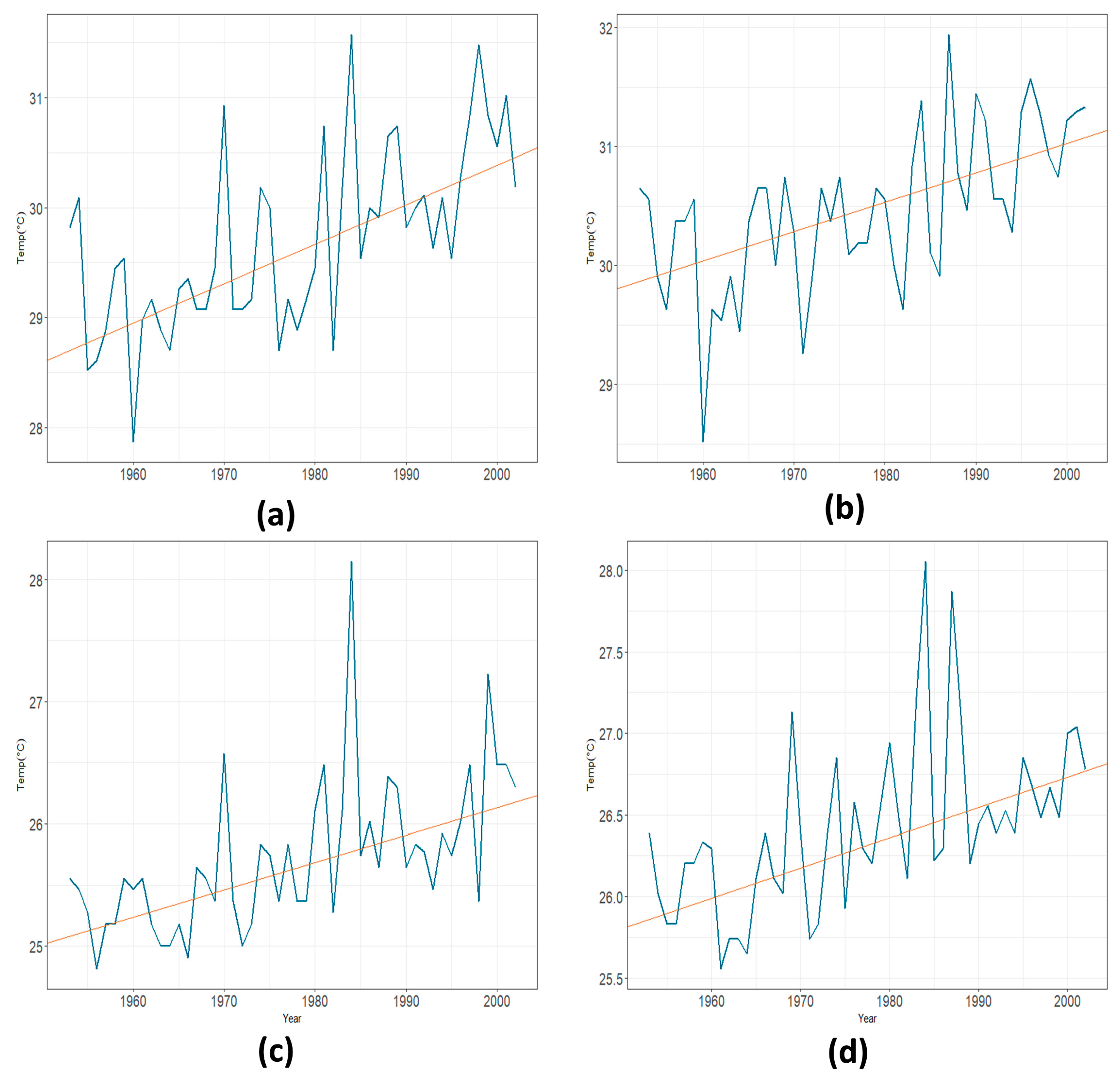
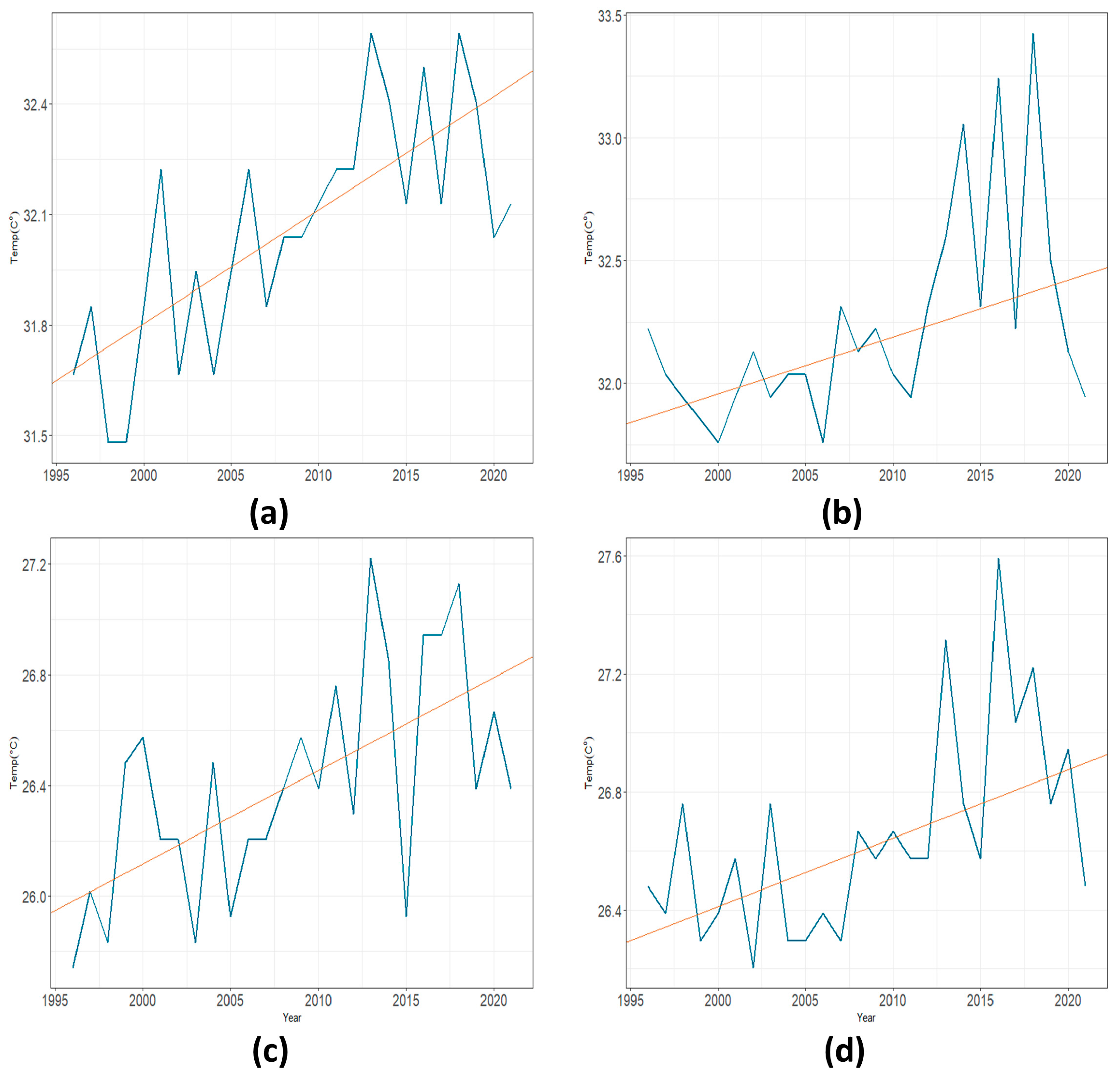
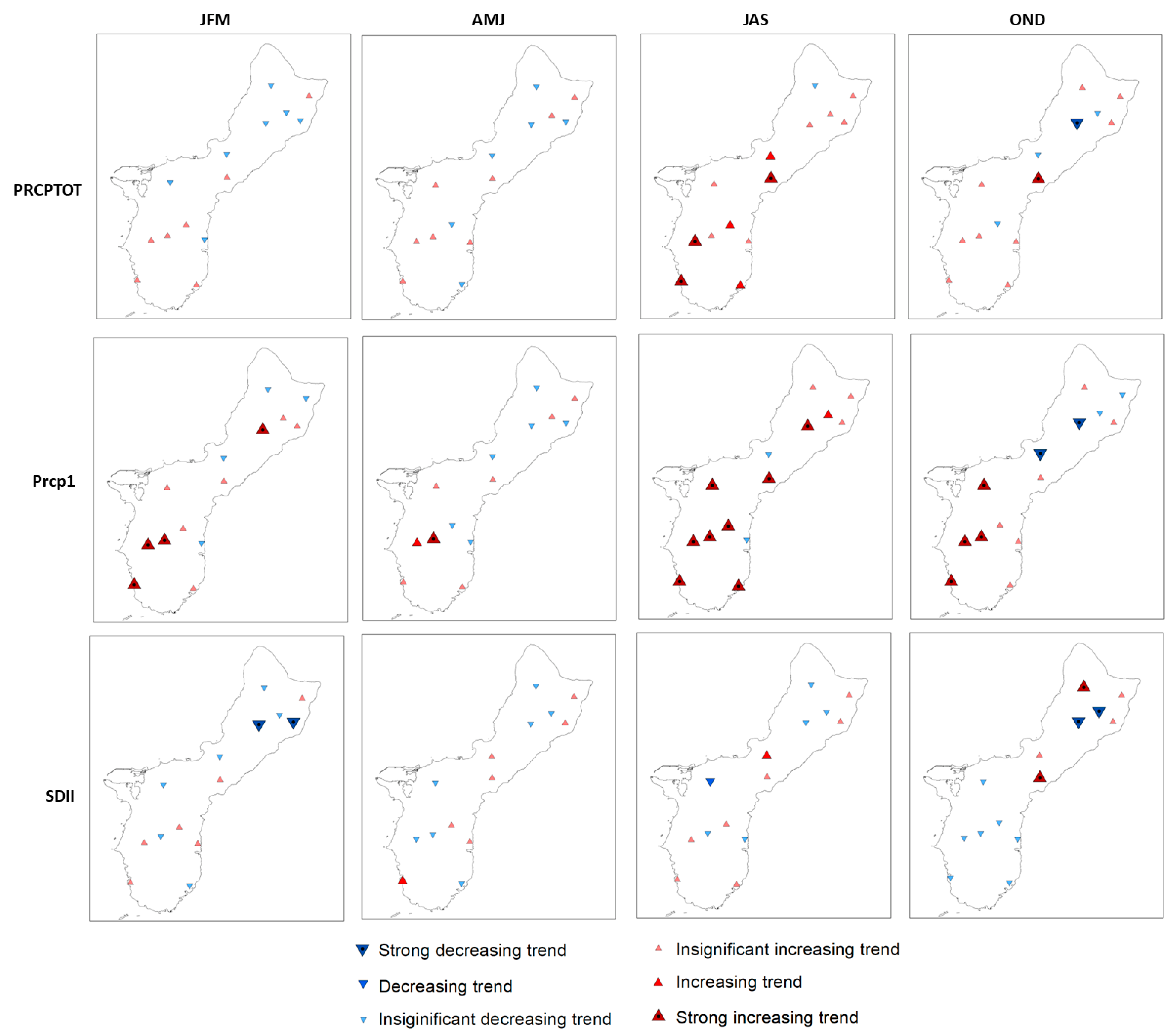
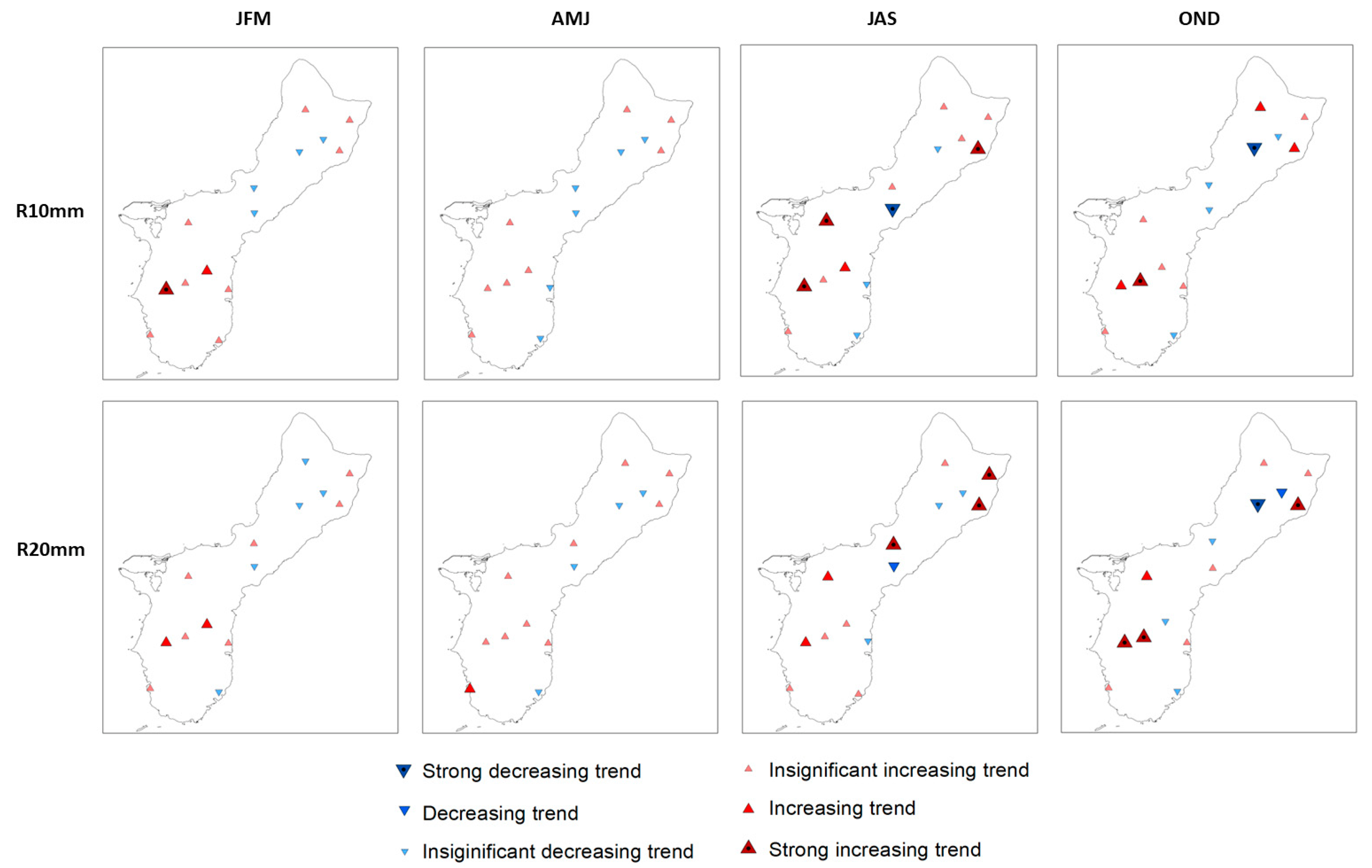
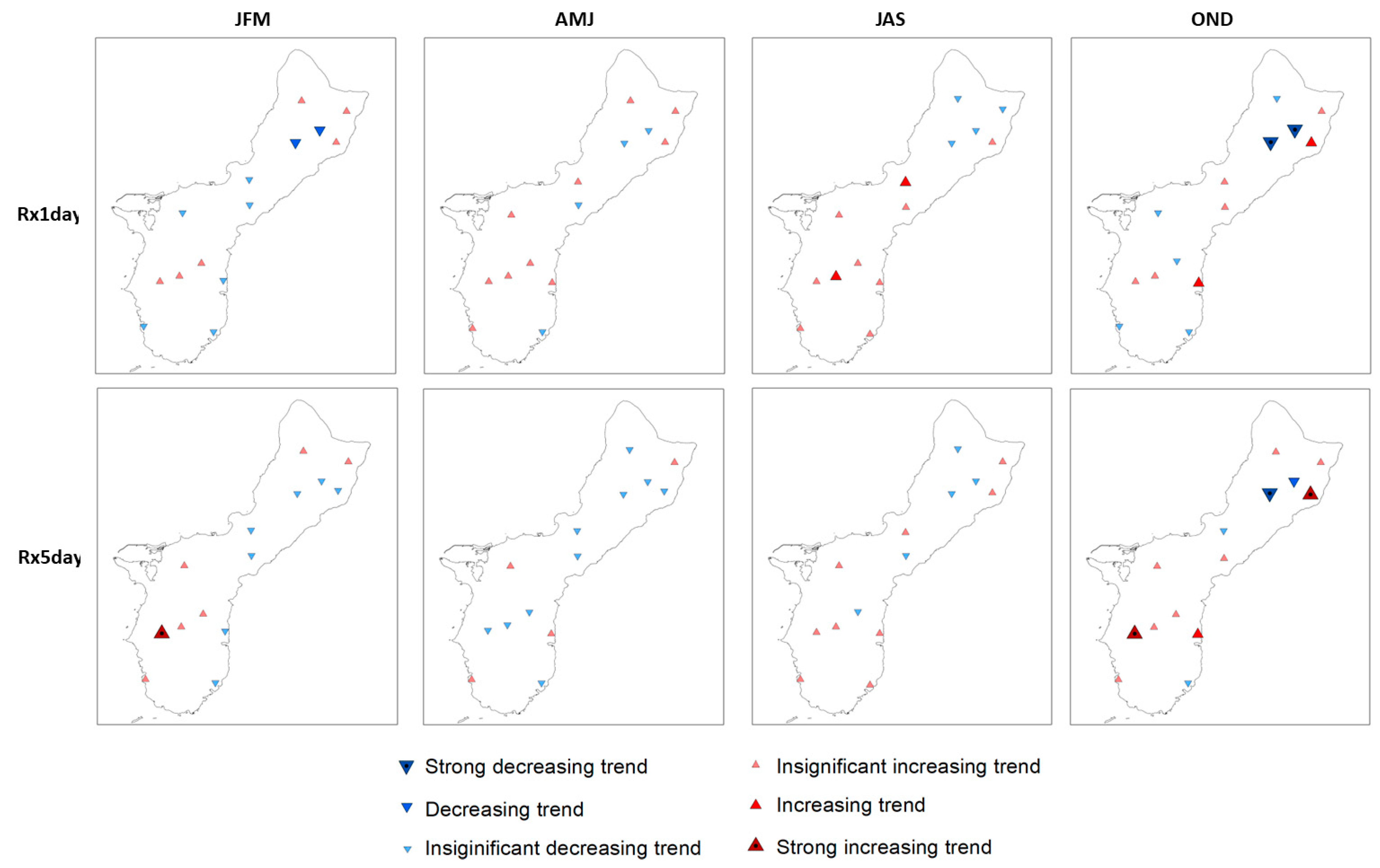
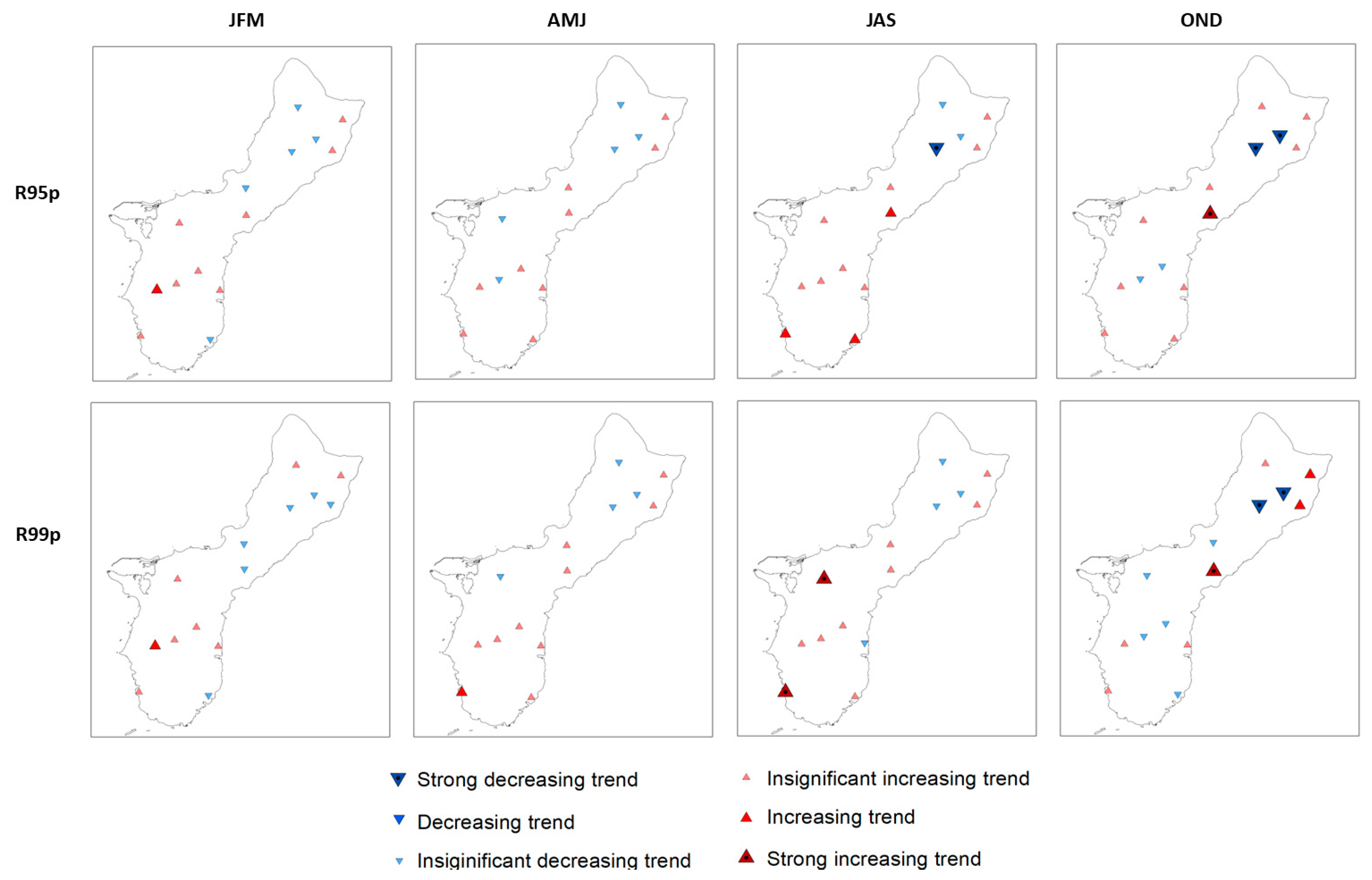
| Name | Latitude | Longitude | Data Period | Data Source | |
|---|---|---|---|---|---|
| Precipitation | Andersen AFB | 13.576 | 144.928 | 1953–2002 | NOAA NCDC |
| Dededo | 13.531 | 144.861 | 1975–2012 | ||
| Guam International AP | 13.483 | 144.800 | 1958–2021 | ||
| Inarajan Station | 13.285 | 144.755 | 1978–2021 | ||
| Mangilao | 13.450 | 144.801 | 1970–2021 | ||
| Pirates Cove | 13.352 | 144.767 | 2004–2019 | ||
| Yigo | 13.548 | 144.893 | 1978–2012 | ||
| Almagosa | 13.353 | 144.683 | 1993–2021 | USGS | |
| Fena | 13.360 | 144.709 | 1994–2021 | ||
| Geomag | 13.589 | 144.868 | 2012–2021 | ||
| Mt Chachao | 13.439 | 144.712 | 1989–2021 | ||
| Mt Santa Rosa | 13.536 | 144.915 | 2002–2021 | ||
| Umatac | 13.292 | 144.662 | 1989–2021 | ||
| Windward Hills | 13.377 | 144.738 | 1974–2021 | ||
| Temperature | Andersen AFB | 13.576 | 144.928 | 1953–2002 | NOAA NCDC |
| Guam International AP | 13.483 | 144.800 | 1958–2021 |
| Index Code | Indicator Name | Definition | Unit |
|---|---|---|---|
| FD | number of frost days | no. of days when TN (daily minimum temperature) < 0 °C | days |
| SU | number of summer days | no. of days when TX (daily maximum temperature) > 25 °C | days |
| ID | number of icing days | no. of days when TX (daily maximum temperature) < 0 °C | days |
| TR | number of tropical nights | no. of days when TN (daily minimum temperature) > 20 °C | days |
| GSL | growing season length | Annual (1 January to 31 December in Northern Hemisphere (NH), 1 July to 30 June in Southern Hemisphere (SH)) count between first span of at least 6 days with daily mean temperature (TG) > 5 °C and first span after 1 July (1 January in SH) of 6 days with TG < 5 °C | days |
| TXx | max TX | monthly maximum value of daily TX | °C |
| TNx | max TN | monthly maximum value of daily TN | °C |
| TXn | min TX | monthly minimum value of daily TX | °C |
| TNn | min TN | monthly minimum value of daily TN | °C |
| TN10p | 10th percentile of TN | value of 10th percentile of daily TN | °C |
| TX10p | 10th percentile of TX | value of 10th percentile of daily TX | °C |
| TN90p | 90th percentile of TN | value of 90th percentile of daily TN | °C |
| TX90p | 90th percentile of TX | value of 90th percentile of daily TX | °C |
| WSDI | warm spell duration index | no. of days with at least 6 consecutive days when TX > 90th percentile | days |
| CSDI | cold spell duration index | no. of days with at least 6 consecutive days when TN < 10th percentile | days |
| DTR | daily temperature range | monthly mean difference between TX and TN | °C |
| PRCPTOT | total PRCP in wet days | sum of daily PRCP amount | mm |
| Prcp1 | percentage of wet days | Percentage of wet days | % |
| SDII | simple PRCP intensity index | total PRCP divided by the no. of wet days (when total PRCP ≥ 1.0 mm) | mm/day |
| R10mm | no. of heavy-rain days exceeding 10 mm/day | count of days when PRCP ≥ 10 mm | days |
| R20mm | no. of heavy-rain days exceeding 20 mm/day | count of days when PRCP ≥ 20 mm | days |
| Rx1day | maximum 1-day PRCP | max 1-day PRCP total | mm |
| Rx5day | maximum 5-day PRCP | max 5-day PRCP total | mm |
| R95pTOT | total PRCP from heavy-rain days (95th percentile) | sum of daily PRCP > 95th percentile | mm |
| R99pTOT | total PRCP from very-heavy-rain days (99th percentile) | sum of daily PRCP > 99th percentile | mm |
| CDD | consecutive dry days | maximum number of consecutive days with RRCP < 1 mm | days |
| CWD | consecutive wet days | maximum number of consecutive days with RRCP ≥ 1 mm | days |
| Time Frame | Statistics | TXx | TXn | TX90p | |||
|---|---|---|---|---|---|---|---|
| AAFB | GIAP | AAFB | GIAP | AAFB | GIAP | ||
| Annual | Tau | 0.386 | 0.291 | 0.212 | 0.207 | 0.381 | 0.095 |
| Sen | 0.037 | 0.000 | 0.000 | 0.000 | 0.024 | 0.000 | |
| Dry | Tau | 0.472 | 0.544 | 0.380 | 0.239 | 0.380 | 0.239 |
| Sen | 0.036 | 0.031 | 0.031 | 0.031 | 0.031 | 0.031 | |
| Wet | Tau | 0.410 | 0.398 | 0.394 | 0.215 | 0.394 | 0.215 |
| Sen | 0.025 | 0.023 | 0.022 | 0.013 | 0.022 | 0.013 | |
| JFM | Tau | 0.407 | 0.557 | 0.354 | 0.155 | 0.354 | 0.155 |
| Sen | 0.031 | 0.029 | 0.026 | 0.023 | 0.026 | 0.023 | |
| AMJ | Tau | 0.419 | 0.353 | 0.317 | 0.269 | 0.317 | 0.269 |
| Sen | 0.041 | 0.025 | 0.033 | 0.040 | 0.033 | 0.040 | |
| JAS | Tau | 0.451 | 0.401 | 0.392 | 0.109 | 0.392 | 0.109 |
| Sen | 0.036 | 0.031 | 0.030 | 0.012 | 0.030 | 0.012 | |
| OND | Tau | 0.272 | 0.221 | 0.302 | 0.224 | 0.302 | 0.224 |
| Sen | 0.019 | 0.013 | 0.018 | 0.015 | 0.018 | 0.015 | |
| Time Frame | Statistics | TNx | TNn | TN10p | |||
|---|---|---|---|---|---|---|---|
| AAFB | GIAP | AAFB | GIAP | AAFB | GIAP | ||
| Annual | Tau | 0.448 | 0.607 | 0.283 | 0.253 | 0.283 | 0.253 |
| Sen | 0.017 | 0.037 | 0.017 | 0.026 | 0.017 | 0.026 | |
| Dry | Tau | 0.456 | 0.445 | 0.399 | 0.326 | 0.399 | 0.326 |
| Sen | 0.022 | 0.034 | 0.019 | 0.031 | 0.019 | 0.031 | |
| Wet | Tau | 0.436 | 0.393 | 0.224 | 0.480 | 0.224 | 0.480 |
| Sen | 0.019 | 0.023 | 0.012 | 0.035 | 0.012 | 0.035 | |
| JFM | Tau | 0.338 | 0.206 | 0.271 | 0.323 | 0.235 | 0.323 |
| Sen | 0.019 | 0.015 | 0.014 | 0.034 | 0.012 | 0.034 | |
| AMJ | Tau | 0.481 | 0.507 | 0.314 | 0.257 | 0.314 | 0.257 |
| Sen | 0.025 | 0.049 | 0.019 | 0.034 | 0.019 | 0.034 | |
| JAS | Tau | 0.433 | 0.375 | 0.272 | 0.569 | 0.272 | 0.569 |
| Sen | 0.019 | 0.031 | 0.015 | 0.046 | 0.015 | 0.046 | |
| OND | Tau | 0.325 | 0.180 | 0.170 | 0.223 | 0.170 | 0.223 |
| Sen | 0.016 | 0.013 | 0.009 | 0.017 | 0.009 | 0.017 | |
| Site | PRCPTOT (mm) | Prcp1 (%) | SDII (mm) | R10mm (days) | R20mm (days) | Site | PRCPTOT (mm) | Prcp1 (%) | SDII (mm) | R10mm (days) | R20mm (days) | |
|---|---|---|---|---|---|---|---|---|---|---|---|---|
| AAFB | Annual | 0.023 | 0.000 | 0.029 | 0.024 | 0.128 | Alamosa | 0.089 | 0.578 | 0.044 | 0.858 | 0.528 |
| Dry | 0.014 | 0.000 | 0.236 | 0.089 | 0.051 | 0.057 | 0.584 | 0.264 | 0.250 | 0.138 | ||
| Wet | 0.036 | 0.000 | 0.243 | −0.05 | 0.056 | 0.064 | 0.437 | −0.071 | 0.667 | 0.444 | ||
| JFM | 0.01 | 0.000 | 0.027 | 0 | 0 | 0.073 | 0.584 | 0.032 | 0.200 | 0.087 | ||
| AMJ | 0.021 | 0.100 | 0.031 | 0.045 | 0 | 0.032 | 0.573 | −0.005 | 0.103 | 0.048 | ||
| JAS | 0.033 | 0.100 | 0.021 | 0.059 | 0.083 | 0.090 | 0.501 | 0.061 | 0.312 | 0.200 | ||
| OND | 0.016 | −0.100 | 0.057 | 0 | 0 | 0.060 | 0.481 | −0.002 | 0.300 | 0.245 | ||
| Dededo | Annual | −0.048 | 0.235 | −0.120 | −0.750 | −0.462 | Fena | 0.071 | 0.754 | −0.042 | 0.800 | 0.310 |
| Dry | −0.045 | 0.192 | −0.434 | −0.229 | −0.087 | 0.038 | 0.643 | −0.386 | 0.206 | 0.048 | ||
| Wet | −0.056 | −0.018 | −1.207 | −0.500 | −0.368 | 0.106 | 0.834 | −0.821 | 0.500 | 0.279 | ||
| JFM | −0.012 | 0.582 | −0.098 | −0.043 | 0.000 | 0.054 | 0.802 | −0.112 | 0.138 | 0.000 | ||
| AMJ | −0.067 | −0.237 | −0.055 | −0.200 | −0.103 | 0.024 | 0.573 | −0.039 | 0.063 | 0.000 | ||
| JAS | 0.007 | 0.289 | −0.128 | 0.000 | −0.102 | 0.067 | 0.735 | −0.032 | 0.156 | 0.000 | ||
| OND | −0.105 | −0.347 | −0.223 | −0.469 | −0.274 | 0.090 | 0.956 | −0.105 | 0.400 | 0.276 | ||
| Guam AP | Annual | 0.002 | −0.100 | 0.018 | −0.075 | 0.027 | Geomag | −0.284 | −0.216 | −0.282 | 1.429 | 0.143 |
| Dry | −0.013 | −0.100 | −0.03 | −0.078 | 0 | −0.239 | −0.753 | −0.661 | 0.333 | 0.000 | ||
| Wet | 0.017 | −0.100 | 0.154 | 0 | 0.063 | 0.013 | 0.482 | 0.154 | 1.400 | 0.500 | ||
| JFM | −0.01 | −0.100 | −0.012 | −0.017 | 0 | −0.369 | −0.738 | −0.198 | 0.333 | −0.250 | ||
| AMJ | −0.008 | −0.100 | 0.003 | −0.029 | 0 | −0.101 | −0.370 | −0.119 | 0.667 | 0.125 | ||
| JAS | 0.03 | 0.000 | 0.042 | 0 | 0.057 | −0.274 | 0.437 | −0.376 | 0.000 | 0.000 | ||
| OND | −0.003 | −0.100 | 0.006 | 0 | 0 | 0.423 | 0.430 | 0.379 | 1.600 | 0.667 | ||
| Inaraja | Annual | 0.042 | 0.401 | −0.009 | −0.077 | 0.037 | Mt. Chachao | 0.029 | 0.432 | −0.059 | 0.821 | 0.400 |
| Dry | 0.008 | 0.355 | −0.110 | −0.067 | −0.067 | 0.004 | 0.177 | −0.248 | 0.136 | 0.103 | ||
| Wet | 0.071 | 0.424 | 0.166 | −0.109 | 0.025 | 0.017 | 0.535 | −0.923 | 0.667 | 0.333 | ||
| JFM | 0.016 | 0.381 | −0.047 | 0.000 | −0.051 | −0.001 | 0.246 | −0.019 | 0.077 | 0.000 | ||
| AMJ | −0.001 | 0.254 | −0.023 | −0.103 | −0.063 | 0.026 | 0.243 | −0.046 | 0.106 | 0.056 | ||
| JAS | 0.096 | 0.401 | 0.054 | −0.042 | 0.000 | 0.003 | 0.562 | −0.143 | 0.318 | 0.184 | ||
| OND | 0.034 | 0.390 | −0.019 | −0.028 | 0.000 | 0.000 | 0.427 | −0.087 | 0.250 | 0.140 | ||
| Mangilao | Annual | 0.067 | 0.156 | 0.067 | −0.343 | −0.171 | Mt. Santa Rosa | 0.081 | 0.319 | 0.039 | 1.866 | 1.165 |
| Dry | 0.018 | 0.112 | 0.249 | −0.074 | −0.040 | −0.020 | 0.110 | −0.530 | 0.250 | 0.250 | ||
| Wet | 0.126 | 0.218 | 0.465 | −0.133 | −0.049 | 0.170 | 0.233 | 1.304 | 1.748 | 1.000 | ||
| JFM | 0.016 | 0.083 | 0.011 | −0.025 | 0.000 | −0.023 | 0.145 | −0.242 | 0.191 | 0.143 | ||
| AMJ | 0.007 | 0.175 | 0.055 | −0.091 | 0.000 | −0.027 | −0.054 | 0.053 | 0.000 | 0.111 | ||
| JAS | 0.119 | 0.262 | 0.053 | −0.155 | −0.095 | 0.182 | 0.222 | 0.070 | 0.732 | 0.646 | ||
| OND | 0.118 | 0.216 | 0.120 | 0.000 | 0.000 | 0.190 | 0.378 | 0.163 | 1.000 | 0.500 | ||
| Pirates Cove | Annual | 0.048 | −0.158 | 0.072 | −0.321 | −0.111 | Umatac | 0.046 | 0.381 | 0.017 | 0.327 | 0.297 |
| Dry | 0.003 | −0.239 | 0.984 | 0.278 | 0.293 | 0.040 | 0.359 | 0.624 | 0.231 | 0.131 | ||
| Wet | 0.106 | 0.017 | 0.241 | 0.222 | 0.042 | 0.093 | 0.477 | 0.262 | 0.212 | 0.167 | ||
| JFM | −0.013 | −0.634 | 0.033 | 0.333 | 0.091 | 0.028 | 0.406 | 0.045 | 0.085 | 0.000 | ||
| AMJ | 0.068 | −0.151 | 0.041 | −0.083 | 0.000 | 0.045 | 0.330 | 0.078 | 0.134 | 0.103 | ||
| JAS | 0.094 | −0.350 | −0.099 | −0.400 | −0.174 | 0.119 | 0.485 | 0.125 | 0.059 | 0.143 | ||
| OND | 0.106 | 0.498 | −0.029 | 0.200 | 0.143 | 0.045 | 0.490 | −0.019 | 0.074 | 0.000 | ||
| Yigo | Annual | −0.017 | 0.319 | −0.065 | −0.381 | −0.273 | Windward | 0.011 | 0.067 | 0.003 | 0.155 | 0.081 |
| Dry | −0.011 | 0.124 | −0.441 | −0.286 | −0.083 | 0.011 | −0.015 | 0.213 | 0.140 | 0.091 | ||
| Wet | 0.004 | 0.189 | −0.962 | −0.286 | −0.313 | 0.019 | 0.091 | −0.062 | 0.092 | 0.047 | ||
| JFM | −0.002 | 0.184 | −0.075 | 0.000 | 0.000 | 0.018 | 0.122 | 0.034 | 0.075 | 0.037 | ||
| AMJ | 0.010 | 0.258 | −0.061 | −0.133 | −0.059 | −0.009 | −0.068 | 0.013 | 0.000 | 0.000 | ||
| JAS | 0.078 | 0.635 | −0.120 | 0.000 | −0.108 | 0.046 | 0.181 | 0.018 | 0.119 | 0.065 | ||
| OND | −0.038 | −0.396 | −0.169 | −0.395 | −0.200 | −0.001 | 0.025 | −0.020 | 0.000 | 0.000 |
| Site | Rx1day (mm) | Rx5day (mm) | R95pTOT (mm) | R99pTOT (mm) | Site | Rx1day (mm) | Rx5day (mm) | R95pTOT (mm) | R99pTOT (mm) | |
|---|---|---|---|---|---|---|---|---|---|---|
| AAFB | Annual | −0.313 | −0.313 | 0.095 | 0.208 | Alamosa | 3.647 | 3.647 | 0.375 | 0.756 |
| Dry | 0.066 | 0.581 | 0.073 | 0.113 | 1.550 | 2.222 | 0.248 | 0.832 | ||
| Wet | 0.03 | 0.442 | 0.123 | 0.294 | 2.310 | 3.653 | 0.155 | 0.667 | ||
| JFM | 0.148 | 0.394 | 0.026 | 0.085 | 1.067 | 1.920 | 0.336 | 0.677 | ||
| AMJ | 0.111 | 0.572 | 0.125 | 0.077 | 0.762 | −0.488 | 0.054 | 0.477 | ||
| JAS | 0 | 0.472 | 0.051 | 0.136 | 1.239 | 2.552 | 0.531 | 0.913 | ||
| OND | 0.18 | 0.162 | 0.141 | 0.369 | 1.141 | 3.777 | 0.110 | 0.694 | ||
| Dededo | Annual | −2.578 | −2.578 | −0.290 | −0.661 | Fena | 2.642 | 2.642 | 0.128 | 0.581 |
| Dry | −0.593 | −2.064 | −0.116 | −0.376 | 1.263 | 1.727 | 0.015 | 0.246 | ||
| Wet | −1.461 | −1.981 | −0.734 | −1.318 | 1.734 | 3.191 | 0.038 | 0.393 | ||
| JFM | −0.540 | −0.914 | −0.090 | −0.368 | 0.150 | 1.369 | 0.080 | 0.097 | ||
| AMJ | −0.457 | −1.036 | −0.190 | −0.339 | 0.496 | −0.777 | −0.091 | 0.477 | ||
| JAS | −0.305 | −0.635 | −0.571 | −0.653 | 1.753 | 3.469 | 0.332 | 0.896 | ||
| OND | −2.332 | −3.714 | −0.738 | −1.679 | 0.361 | 2.247 | −0.169 | −0.025 | ||
| Guam AP | Annual | 0.305 | −0.286 | 0.016 | 0.072 | Geomag | −19.304 | −19.304 | 0.013 | −2.540 |
| Dry | 0.191 | −0.520 | 0.013 | 0.04 | 4.205 | −0.381 | −1.298 | 1.080 | ||
| Wet | 0.2 | −0.073 | 0.06 | 0.081 | −21.209 | −19.304 | −0.560 | −1.245 | ||
| JFM | −0.113 | −0.683 | −0.001 | −0.039 | 4.657 | 4.064 | −1.026 | 0.953 | ||
| AMJ | 0.254 | −0.796 | 0.013 | 0.118 | 0.889 | −8.033 | −0.219 | −1.630 | ||
| JAS | 0.447 | 0.142 | 0.125 | 0.23 | −21.209 | −34.629 | −1.565 | −6.745 | ||
| OND | 0.061 | −0.018 | 0.002 | −0.017 | −0.127 | 6.763 | 1.441 | 0.857 | ||
| Inaraja | Annual | −0.286 | −0.286 | 0.237 | 0.076 | Mt. Chachao | 0.816 | 0.816 | 0.100 | −0.348 |
| Dry | −0.098 | −0.520 | 0.099 | 0.113 | −0.044 | 0.883 | 0.006 | −0.116 | ||
| Wet | −0.322 | −0.073 | 0.346 | 0.134 | 0.795 | 1.386 | −0.065 | 0.392 | ||
| JFM | −0.237 | −0.683 | −0.062 | −0.006 | −0.073 | 0.688 | 0.086 | 0.135 | ||
| AMJ | −0.074 | −0.796 | 0.085 | 0.114 | 0.000 | 0.541 | −0.033 | −0.099 | ||
| JAS | 0.000 | 0.142 | 0.327 | 0.091 | 0.955 | 1.386 | 0.082 | 0.862 | ||
| OND | −0.385 | −0.018 | 0.019 | −0.092 | −0.798 | 1.194 | 0.015 | −0.208 | ||
| Mangilao | Annual | −0.178 | −0.178 | 0.233 | 0.521 | Mt. Santa Rosa | 3.821 | 3.821 | 0.328 | 1.140 |
| Dry | −0.271 | −0.808 | 0.162 | −0.053 | −0.145 | −2.977 | 0.119 | 0.228 | ||
| Wet | 0.492 | −0.198 | 0.254 | 0.208 | 2.853 | 4.709 | 0.732 | 2.706 | ||
| JFM | −0.092 | −0.508 | 0.124 | −0.152 | 0.318 | −1.521 | 0.175 | −0.231 | ||
| AMJ | −0.062 | −0.635 | 0.195 | 0.058 | 0.305 | −0.018 | 0.089 | 0.333 | ||
| JAS | 0.254 | −1.664 | 0.327 | 0.222 | 3.419 | 4.699 | 0.890 | 1.819 | ||
| OND | 0.381 | 1.067 | 0.391 | 0.373 | 3.144 | 6.350 | 0.654 | 2.073 | ||
| Pirates Cove | Annual | 5.854 | 5.854 | 0.094 | 1.728 | Umatac | 2.264 | 2.264 | 0.381 | 0.565 |
| Dry | −0.469 | 0.586 | 0.801 | 1.132 | 0.585 | 2.447 | 0.311 | 0.708 | ||
| Wet | 7.295 | 8.113 | 0.637 | 0.233 | 1.487 | 2.390 | 0.370 | 0.611 | ||
| JFM | −1.270 | −1.755 | 0.433 | 0.160 | −0.205 | 0.205 | 0.253 | 0.226 | ||
| AMJ | 1.727 | 1.355 | 0.495 | 1.027 | 0.381 | 1.055 | 0.219 | 0.635 | ||
| JAS | 4.410 | 6.512 | 0.205 | −0.507 | 1.796 | 2.319 | 0.633 | 1.503 | ||
| OND | 3.598 | 5.956 | 0.528 | 0.064 | −0.248 | 1.257 | 0.211 | 0.132 | ||
| Yigo | Annual | −1.711 | −1.711 | −0.107 | −0.394 | Windward | −0.088 | −0.088 | 0.017 | 0.157 |
| Dry | −0.711 | −1.651 | −0.170 | −0.166 | 0.235 | 0.548 | 0.128 | 0.236 | ||
| Wet | −0.720 | −1.722 | −0.534 | −0.389 | 0.602 | −0.194 | −0.060 | 0.136 | ||
| JFM | −0.670 | −1.295 | −0.109 | −0.496 | 0.120 | 0.165 | 0.097 | 0.208 | ||
| AMJ | −0.282 | −1.746 | −0.201 | −0.007 | 0.008 | −0.027 | 0.037 | 0.062 | ||
| JAS | −0.310 | −0.776 | −0.371 | −0.237 | 0.545 | −0.064 | 0.146 | 0.369 | ||
| OND | −0.750 | −1.981 | −0.515 | −0.847 | −0.030 | 0.621 | −0.169 | −0.075 |
Disclaimer/Publisher’s Note: The statements, opinions and data contained in all publications are solely those of the individual author(s) and contributor(s) and not of MDPI and/or the editor(s). MDPI and/or the editor(s) disclaim responsibility for any injury to people or property resulting from any ideas, methods, instructions or products referred to in the content. |
© 2023 by the authors. Licensee MDPI, Basel, Switzerland. This article is an open access article distributed under the terms and conditions of the Creative Commons Attribution (CC BY) license (https://creativecommons.org/licenses/by/4.0/).
Share and Cite
Yeo, M.-H.; Patil, U.D.; Chang, A.; King, R. Changing Trends in Temperatures and Rainfalls in the Western Pacific: Guam. Climate 2023, 11, 81. https://doi.org/10.3390/cli11040081
Yeo M-H, Patil UD, Chang A, King R. Changing Trends in Temperatures and Rainfalls in the Western Pacific: Guam. Climate. 2023; 11(4):81. https://doi.org/10.3390/cli11040081
Chicago/Turabian StyleYeo, Myeong-Ho, Ujwalkumar D. Patil, Adriana Chang, and Romina King. 2023. "Changing Trends in Temperatures and Rainfalls in the Western Pacific: Guam" Climate 11, no. 4: 81. https://doi.org/10.3390/cli11040081
APA StyleYeo, M.-H., Patil, U. D., Chang, A., & King, R. (2023). Changing Trends in Temperatures and Rainfalls in the Western Pacific: Guam. Climate, 11(4), 81. https://doi.org/10.3390/cli11040081







